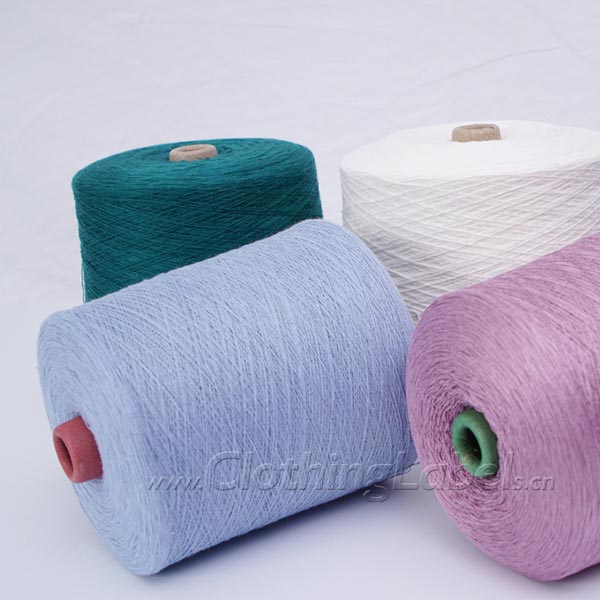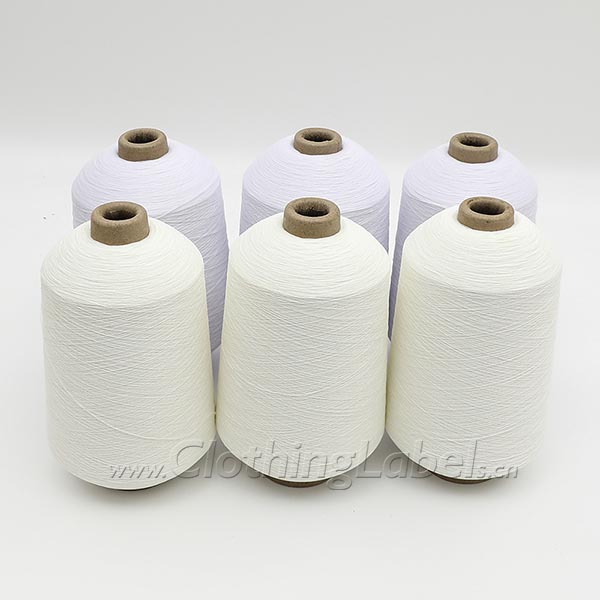Recycled polyester yarn is produced by melting and drawing recycled polyester bottle flakes, which can make eco-friendly recycled woven labels, clothing trims, RPET fabrics. The sustainable rpet yarn from post-consumer plastic bottles can make polyester staple fibers and nonwovens. We can use it to produce hollow fibers and make filling materials such as cotton wool. In the production of apparel fabrics, the regenerated green yarn can be blended with other fibers. The blending rate is as high as 90%.
The low-carbon nature of its source allows it to create a new concept in the field of regeneration. 100% of its recycled material can regenerate PET fiber. So, that effectively reduced waste in the air. Its length is generally 32 to 102mm. And the fineness has many specifications from 1.5D-20D. Then, it belongs to the full utilization of renewable resources. Thus, it has a large market because of its low cost and good performance.
ClothingLabels.CN is a recycled Polyester Yarn Manufacturer & supplier. The yarn has passed the European OEKO-TEX Standard 100 ecological environmental protection certification. And the international GRS global recycling standard certification. So, many brands and factories that pursue environmental protection can produce recycled woven labels and various clothing accessories here.
Advantages of recycled polyester yarn
PET recycled yarn can reduce the amount of oil used. Each ton of finished yarn saves 6 tons of oil. This will effectively reduce carbon dioxide emissions. Besides, it saves nearly 80% of energy compared to the normal process of producing polyester fiber. Therefore, recycled polyester yarn has made a certain contribution to reducing air pollution and controlling the greenhouse effect.
Using biodegradable yarns, garments that are discarded and landfilled can decompose quickly. In just three years, it gradually decomposed and returned to its natural environment. Other fibers take decades to break down.
The product has wide applications. We can do any kind of processing on it. Such as weaving, knitting, dyeing, finishing, etc. This provides a new type of textile material for the textile and garment industry.
It feels good to wear. And woven labels and garments made of this yarn are comfortable, breathable, washable, and quick-drying.
Garments using biodegradable PET yarns have all the advantages of conventional fabrics. In addition, it guarantees storage and has the same shelf life.
Features of recycled polyester yarn
- 1. Recycled yarn from discarded mineral water bottles and Coke bottles, and does not require petrochemical raw materials.
- 2. Sustainable yarn made from recycled plastic to protect against air pollution.
- 3. Durable, and soft material.
- 4. It has good elasticity and long service life, which is not easy to fluff.
Recycled polyester yarn details
- Product name: recycled polyester yarn;
- Color: Various colors, such as white, black, pink, yellow, beige, etc;
- Material: 100% recycled polyester, polyester, cotton, linen, nylon, silk, chunky yarn, etc;
- Recycled pure polyester yarn: 10, 20, 32, 40, 60, etc;
- Spinning process: ring spinning;
- Function: Antibacterial, moisture-wicking, degradable, etc;
- Uses: wool weaving, fly weaving, knitting, weaving, sewing, etc;
- Specific uses: garments, clothing trims & accessories, tents, bags, curtains, medical, sportswear, decorative fabrics, mountaineering clothes, mother and baby clothes, cushions, pillows, sofas, special uniforms, etc.
Color sample chart of recycled polyester yarn
To view woven labels’ yarn color sample chart
RPET recycled polyester yarn-specifications
- Regenerated DTY: 30D, 40D, 50D, 75D, 100D, 150D, 300D…
- Regeneration FDY: 20D, 30D, 40D, 50D, 75D, 100D, 150D…
- Regenerated staple fiber: 10S, 16S, 21S, 26S, 32S, 40S, 60S…
- Regenerated POY: 50D, 75D, 100D, 150D…
RPET yarn product use in daily life
The fabric made of recycled polyester yarn has good wear resistance, moisture absorption, and breathability. And it can replace the virgin fiber widely used in all kinds of textile fabrics and clothing. Such as T-shirts, hats, gloves, jackets, handbags, drawstring pouches, gift bags, shopping bags, luggage, carpets, etc.
Also, recycled polyester yarn from plastic bottles is ideal for all kinds of clothing labels and apparel. Such as woven or printed labels, children’s clothing, windbreaker, down clothing, scarves, towels, pajamas, shoe materials, etc.
What is the difference between recycled polyester and polyester?
Different performance
1. The strength property of recycled polyester fibers is less good.
2. The strength property of polyester fiber is relatively good.
The raw materials are different
1. Recycled polyester is re-granulated with recycled materials (PET bottle flakes, foam materials, etc.), and then drawn into fibers.
2. Polyester is made of chemical raw materials PTA and MEG polymerized and drawn into fibers.
Recycled woven labels
1. Satin woven label:
It does not sting the skin, the surface is smooth, and the hand feel is soft. In general, it has two colors: black background and white background.
2. Flat woven label:
It has a comfortable hand feel, and clear pattern, and will not sting the skin.
3. High-density plane woven label:
The density is controllable. So, the higher the density, the clearer the pattern. Second, it is rich in color, and the surface of the woven material is non-reflective.
4. Shiny yarn woven label:
There are many categories, including gold, silver, and blue light lines. Thus, it’s suitable for high-end coats.
Types of recycled woven labels from RPET yarn
Damask woven label
It is a cutting-edge woven label with yarn on the back. There is a difference between normal and high density. Its material surface is dull, and the weaving content is clear. Any color can be customized. and there are two types of cutting methods: hot-cutting and laser-cutting. There is no upper limit requirement at all for the width. The widest can be 110CM. Woven labels that are too narrow are generally size labels or ribbons.
Salvage(satin) woven label
Its surface is glossy. The edges are smooth and detailed. The width is required to be between 1CM and 5CM. The maximum is 5.0CM. But, it has no more than four colors. And its woven logo has obvious gaps. Therefore, we can distinguish it well from damask woven labels. Meanwhile, it is soft to the touch and does not sting the skin. So we think it is suitable for high-end clothing.
Crochet woven label
The crocheted woven label combines the advantages of many materials. Its weave materials are diverse. And it has high density and strong texture. At the same time, the style is novel and the material is comfortable. Besides, the width is required to be between 0.6CM and 3.5CM. The maximum is 3.5CM.
Order process
- Step 1. Have a live chat with us or Email us with all details. Such as artwork, materials, size, colors, technics, destination, and payment terms. If you have no ideas, please attach our similar product pictures;
- Step 2. Once received your details, we’ll reply to you in a short time. And quote you the price, the freight charge, and the transfer charge;
- Step 3. After you confirmed the price, we will issue the invoice;
- Step 4. Make designs if you don’t have them after receiving the order payment;
- Step 5. If you prefer to make samples first. We will proceed with the samples after receiving your sample charge. If not, please skip step 6;
- Step 6. After receiving your design or sample approval. We will start producing the bulk;
- Step 7. Bulk production and inspection and handover of the goods;
- Step 8. After-sales service;


